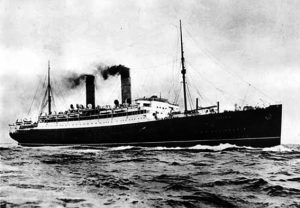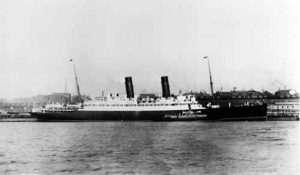 RMS Laconia was built for Cunard by Swan, Hunter & Wigham Richardson at Newcastle. She was a twin-funnelled, twin-propeller steamship, 625 feet long, 18,000grt. Laconia sailed on her maiden voyage on 20th January 1912, from Liverpool to New York, but was later on the Liverpool to Boston route. Primarily used as an emigrant ship, she could carry 300 in First Class, 350 in Second Class and 2,200 in Third Class. Requisitioned in October 1914, she was converted into an armed merchant cruiser, based at Simonstown in South Africa. Returned to Cunard in July 1916, she was converted back to her peacetime configuration and reverted to her commercial service by 9th September 1916.
RMS Laconia was built for Cunard by Swan, Hunter & Wigham Richardson at Newcastle. She was a twin-funnelled, twin-propeller steamship, 625 feet long, 18,000grt. Laconia sailed on her maiden voyage on 20th January 1912, from Liverpool to New York, but was later on the Liverpool to Boston route. Primarily used as an emigrant ship, she could carry 300 in First Class, 350 in Second Class and 2,200 in Third Class. Requisitioned in October 1914, she was converted into an armed merchant cruiser, based at Simonstown in South Africa. Returned to Cunard in July 1916, she was converted back to her peacetime configuration and reverted to her commercial service by 9th September 1916.
 On 25th February 1917, heading to the UK from New York, Laconia was torpedoed by the German submarine U-50, six miles off Fastnet. Twelve aboard were killed, six crew and six passengers, including two Americans. There was a great deal of publicity across the USA about German atrocities, and the sinking was said to have had a major effect on bringing America into the Great War. The wreck of Laconia was found in 1986, and recovery efforts were instituted to recover her cargo. Reports vary, but she was carrying between 800 and 1000 bars of silver, 1,232 boxes of silver coins, and over 4.5 million brass shell cases. Other cargo included 3,000 tons of steel and nearly 3,000 bales of cotton. A salvage company, Deep6, commenced recovery in 2008, and later agreed a contract with the UK Department of Transport to establish salvage rights. Another salvage company, Odyssey, later attempted to establish title in the courts but had to withdraw their claim later. Captain Irvine remained with Cunard and went on to command a number of other vessels, including the second Laconia in the 1920s.
On 25th February 1917, heading to the UK from New York, Laconia was torpedoed by the German submarine U-50, six miles off Fastnet. Twelve aboard were killed, six crew and six passengers, including two Americans. There was a great deal of publicity across the USA about German atrocities, and the sinking was said to have had a major effect on bringing America into the Great War. The wreck of Laconia was found in 1986, and recovery efforts were instituted to recover her cargo. Reports vary, but she was carrying between 800 and 1000 bars of silver, 1,232 boxes of silver coins, and over 4.5 million brass shell cases. Other cargo included 3,000 tons of steel and nearly 3,000 bales of cotton. A salvage company, Deep6, commenced recovery in 2008, and later agreed a contract with the UK Department of Transport to establish salvage rights. Another salvage company, Odyssey, later attempted to establish title in the courts but had to withdraw their claim later. Captain Irvine remained with Cunard and went on to command a number of other vessels, including the second Laconia in the 1920s.
